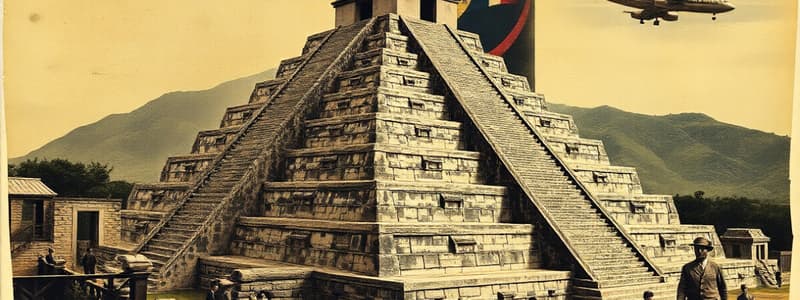Podcast
Questions and Answers
Which of the following accurately describes the Aztec Empire's geographic features?
Which of the following accurately describes the Aztec Empire's geographic features?
- It thrived in the arid deserts of northwestern Mexico.
- It was primarily located in coastal regions of Mexico.
- It included the Valley of Mexico and significant lakes like Lake Texcoco. (correct)
- It was exclusively within the tropical jungles of southern Mexico.
What was the role of the nobility in the Aztec social structure?
What was the role of the nobility in the Aztec social structure?
- They served as slaves to commoners and serfs.
- They were primarily priests and wealthy landowners with significant influence. (correct)
- They were common laborers who worked the land.
- They managed all agricultural production in the empire.
What was a primary religious practice of the Aztecs to honor their gods?
What was a primary religious practice of the Aztecs to honor their gods?
- Practicing exclusive monotheism focused on a single deity.
- Conducting human sacrifices to ensure agricultural fertility. (correct)
- Celebrating only seasonal festivals without deeper rituals.
- Building schools for education of the youth.
What was the primary agricultural system utilized by the Aztecs?
What was the primary agricultural system utilized by the Aztecs?
Which feature best characterizes Aztec art and architecture?
Which feature best characterizes Aztec art and architecture?
Study Notes
Geography Of The Aztec Empire
- Located in central Mexico, primarily in the Valley of Mexico.
- Included modern-day Mexico City and surrounding areas.
- Comprised of highlands and valleys, with significant lakes (e.g., Lake Texcoco).
- Climate: varied but generally temperate with distinct wet and dry seasons.
Aztec Social Structure
- Hierarchical society divided into classes:
- Nobility (Pipiltin): Wealthy landowners, priests, and military leaders.
- Commoners (Macehualtin): Farmers, artisans, and merchants; made up the majority.
- Serfs (Tlacotin): Workers bound to the land; had limited rights.
- Slaves (Tlacotli): Usually war captives; could buy freedom.
- Gender roles: Men typically held public roles; women managed households and participated in certain trades.
Religious Practices Of The Aztecs
- Polytheistic belief system with numerous gods (e.g., Huitzilopochtli, Quetzalcoatl).
- Rituals included human sacrifices to appease gods and ensure agricultural fertility.
- Significant ceremonies held in large temples, such as Templo Mayor in Tenochtitlan.
- Religion intertwined with politics; rulers often acted as mediators to the divine.
Economic Systems In Aztec Society
- Based on agriculture, primarily maize, beans, and squash (the "Mesoamerican triad").
- Advanced agricultural techniques, including chinampas (floating gardens).
- Trade networks: extensive marketplaces (e.g., Tlatelolco) facilitated exchange of goods.
- Tribute system: conquered peoples paid tribute in goods and resources to the empire.
Art And Architecture Of The Aztecs
- Known for intricate stone carvings, pottery, and jewelry.
- Architecture featured grand temples, pyramids, and palaces, often adorned with sculptures.
- Use of bright colors in murals and textiles; themes often depicted religious and historical events.
- Codices: illustrated manuscripts that recorded history, religion, and daily life.
Geography Of The Aztec Empire
- Central Mexico's Aztec Empire covered the Valley of Mexico, including present-day Mexico City.
- The region featured highlands, valleys, and significant bodies of water like Lake Texcoco.
- Climate varied but was predominantly temperate with distinct wet and dry seasons.
Aztec Social Structure
- Society was hierarchical, classified into four main groups:
- Nobility (Pipiltin): Included wealthy landowners, priests, and military leaders holding political power.
- Commoners (Macehualtin): Made up the majority, comprised farmers, artisans, and merchants.
- Serfs (Tlacotin): Bound to the land, with limited rights and responsibilities.
- Slaves (Tlacotli): Typically war captives, who could gain freedom through purchase.
- Gender roles were defined; men held public positions while women managed household affairs and engaged in specific trades.
Religious Practices Of The Aztecs
- The Aztecs practiced polytheism, worshipping numerous gods such as Huitzilopochtli and Quetzalcoatl.
- Human sacrifices were integral to rituals aimed at appeasing deities and ensuring agricultural productivity.
- Major ceremonies occurred in prominent temples, notably Templo Mayor in Tenochtitlan, reinforcing the connection between religion and state.
- Rulers served as intermediaries between the divine and the people, emphasizing the political role of religion.
Economic Systems In Aztec Society
- The economy was heavily reliant on agriculture, focusing on the Mesoamerican triad: maize, beans, and squash.
- Advanced farming techniques, particularly chinampas (floating gardens), optimized agricultural output.
- Trade networks were extensive, with bustling marketplaces like Tlatelolco that facilitated exchange of goods.
- A tribute system required conquered peoples to supply goods and resources, contributing to the empire's wealth.
Art And Architecture Of The Aztecs
- Renowned for intricate artwork including stone carvings, pottery, and artisan jewelry.
- Architectural achievements featured impressive temples, pyramids, and palaces adorned with sculptures.
- Bright colors highlighted murals and textiles, often illustrating religious and historical significance.
- Codices served as important illustrated manuscripts, chronicling history, religious beliefs, and daily life activities.
Studying That Suits You
Use AI to generate personalized quizzes and flashcards to suit your learning preferences.
Description
Explore the fascinating geography and social structure of the Aztec Empire. Learn about its hierarchical classes, significant cities like Mexico City, and the rich religious practices of this ancient civilization. Discover how geography influenced their society and lifestyle.




